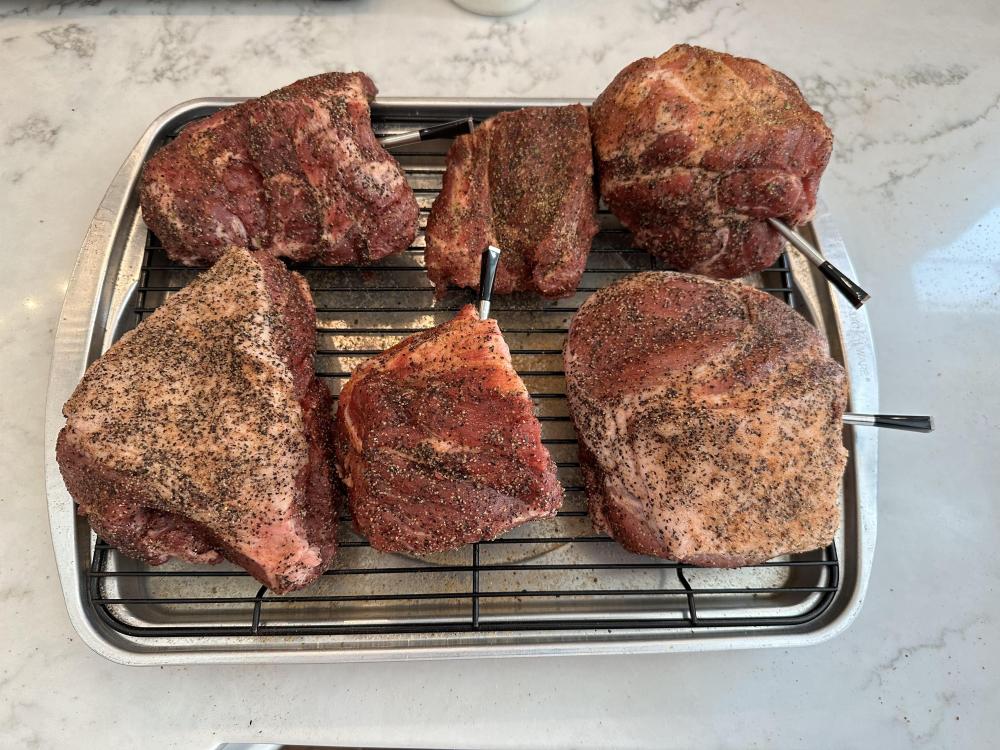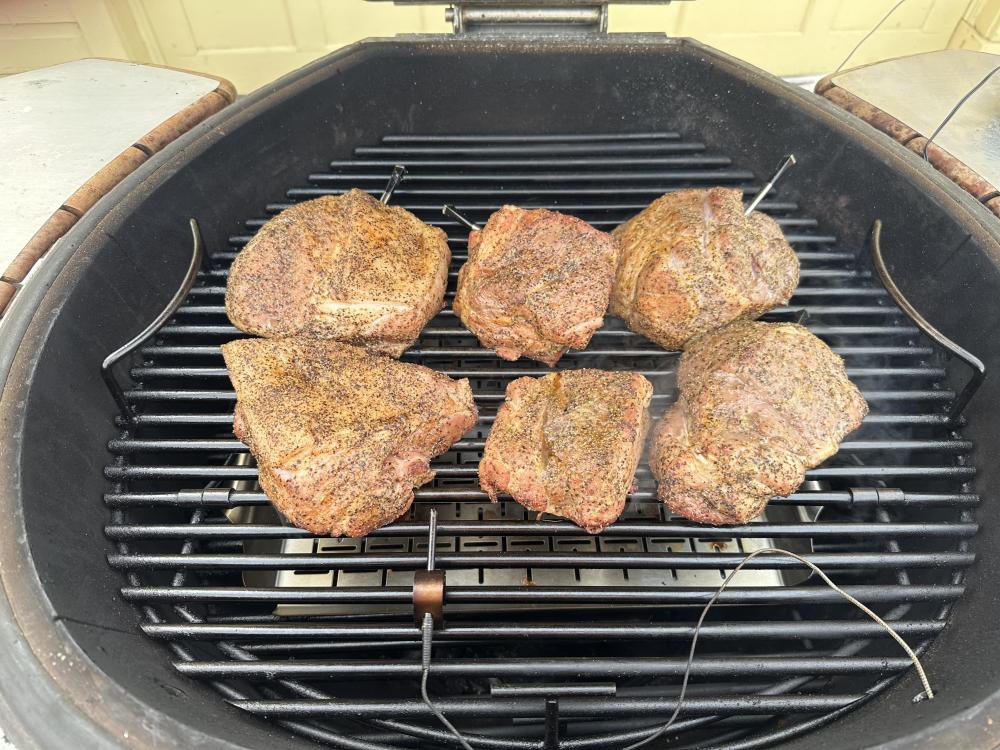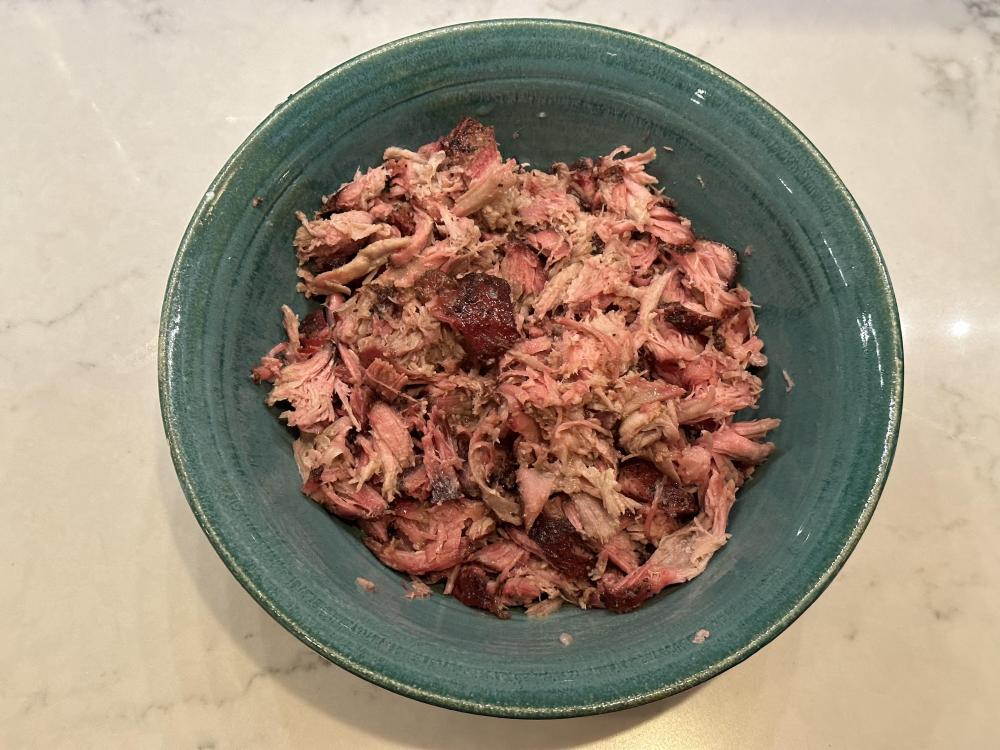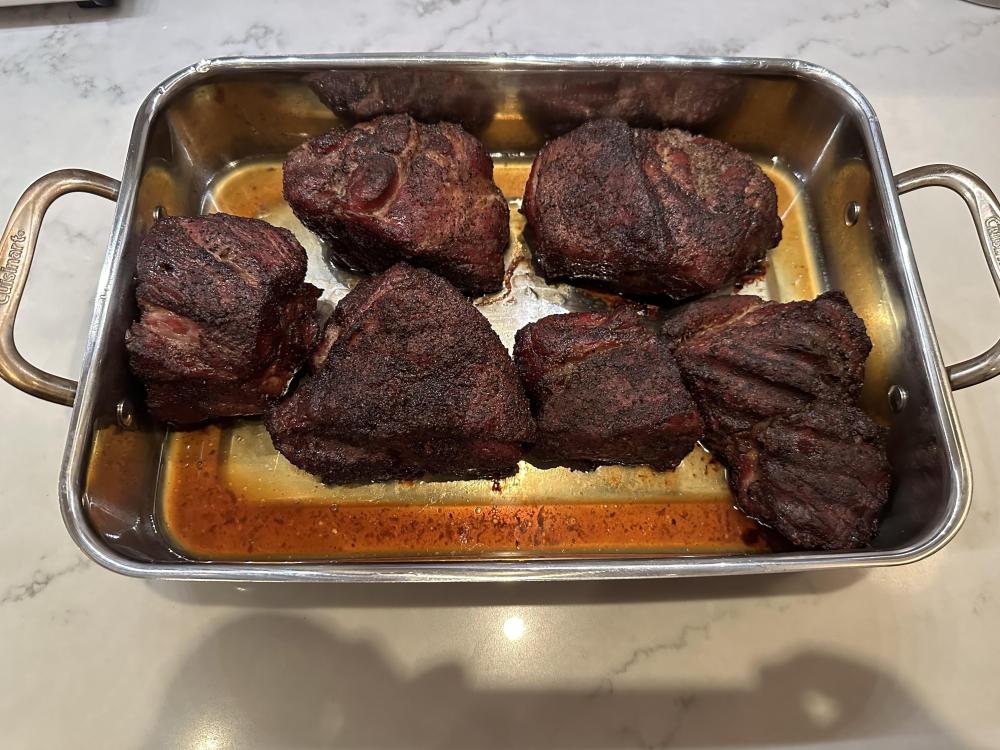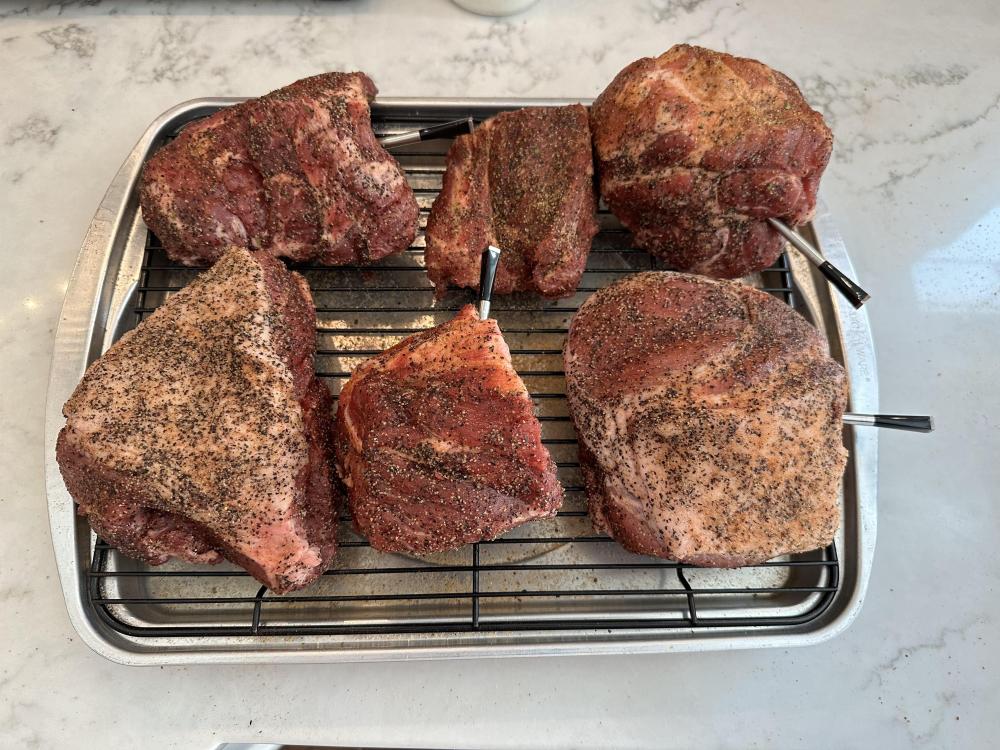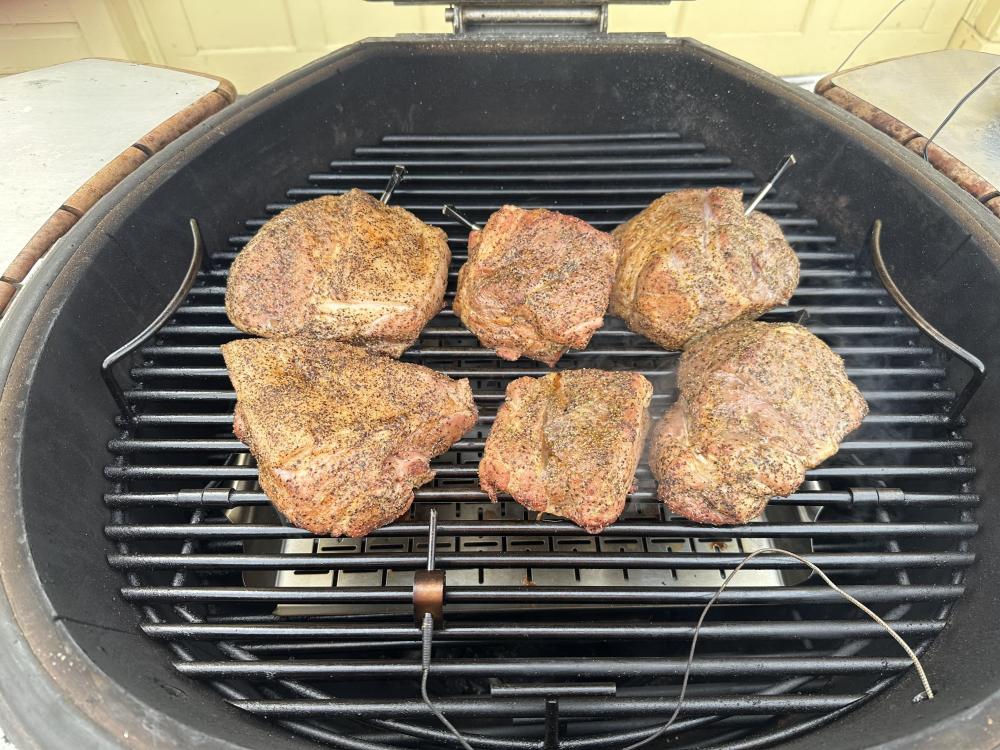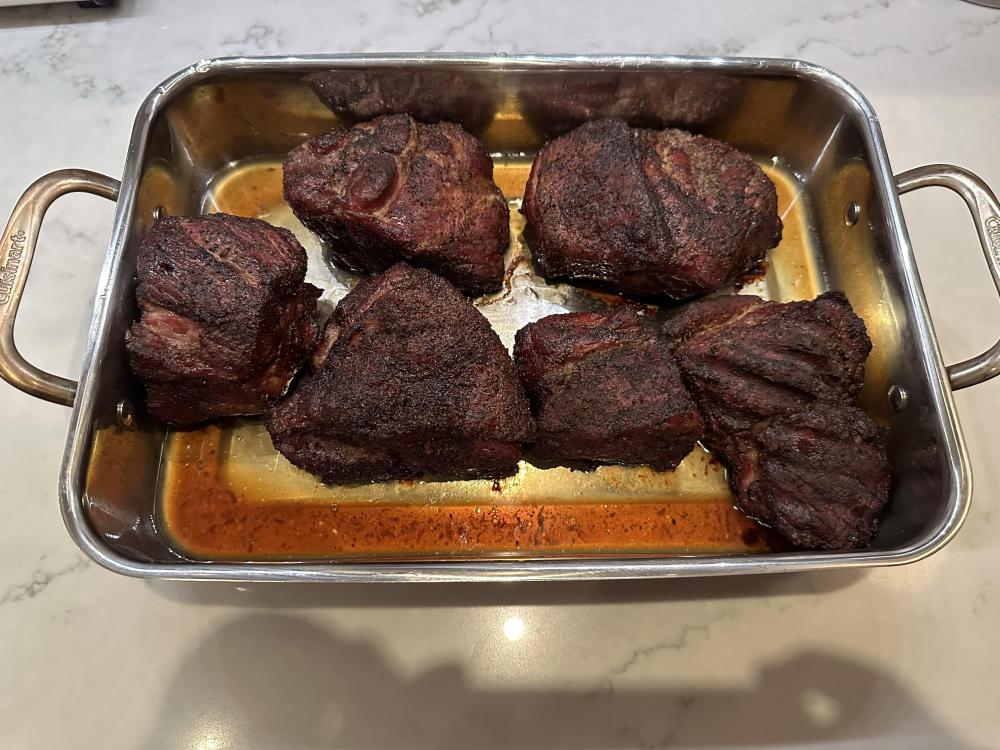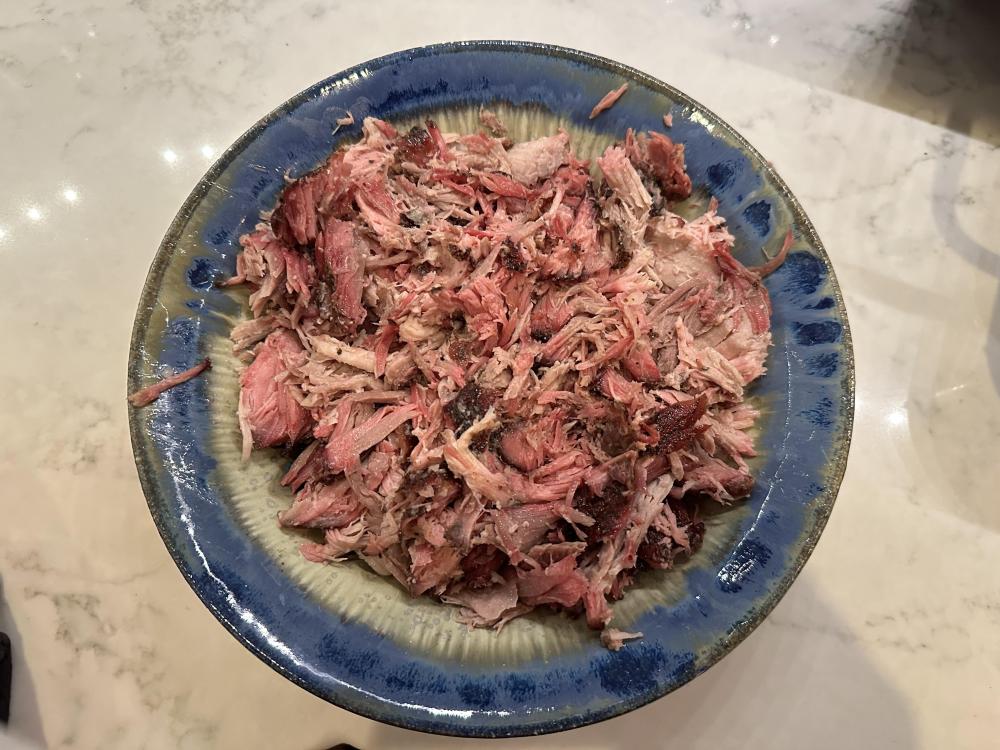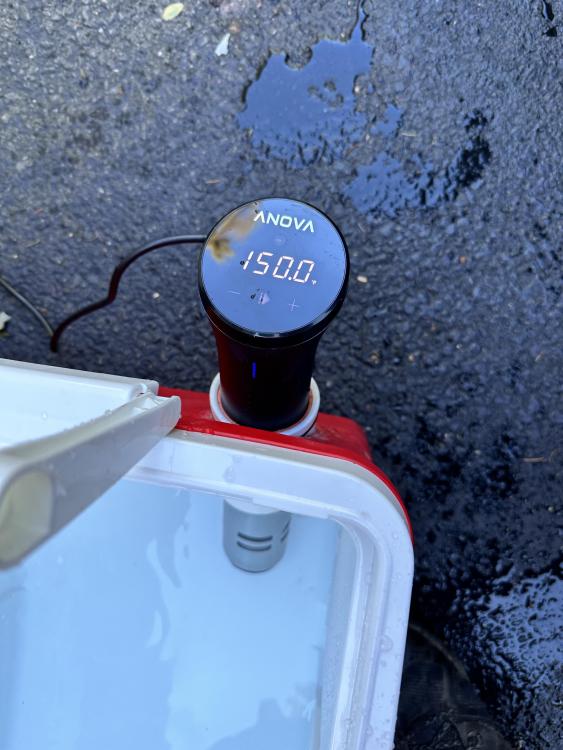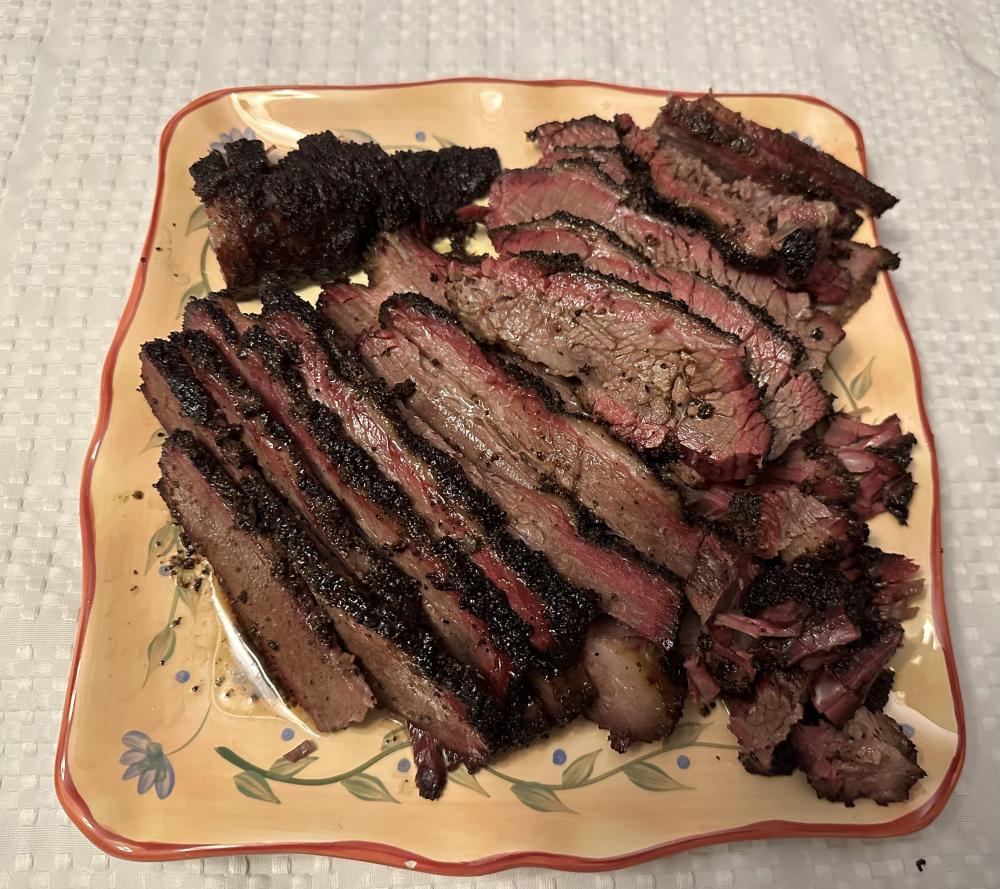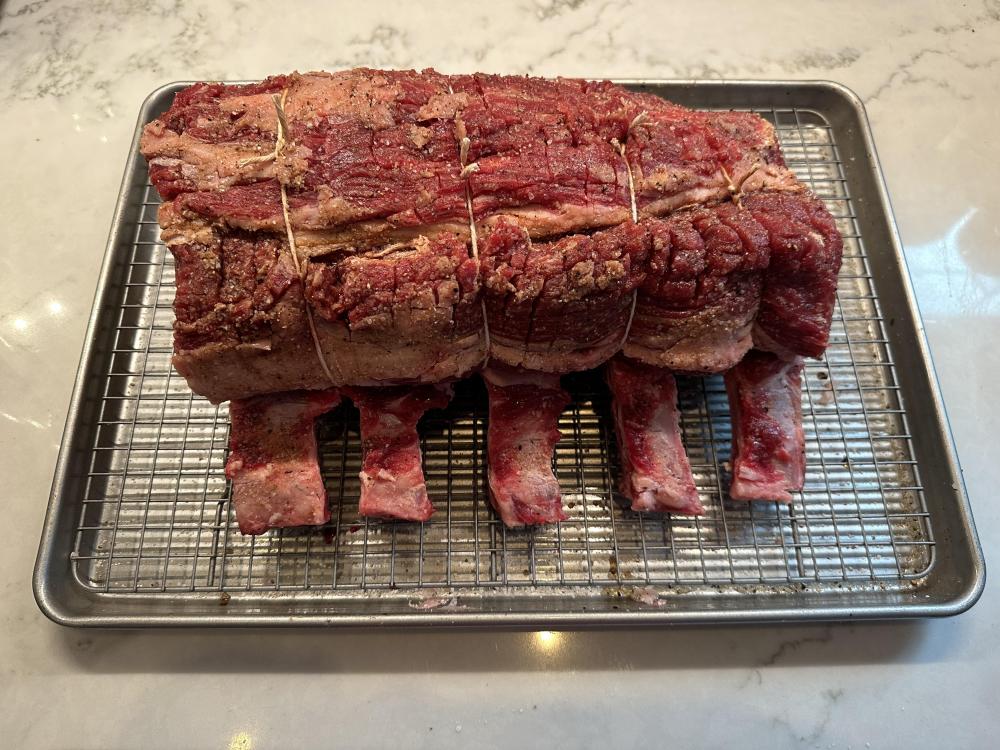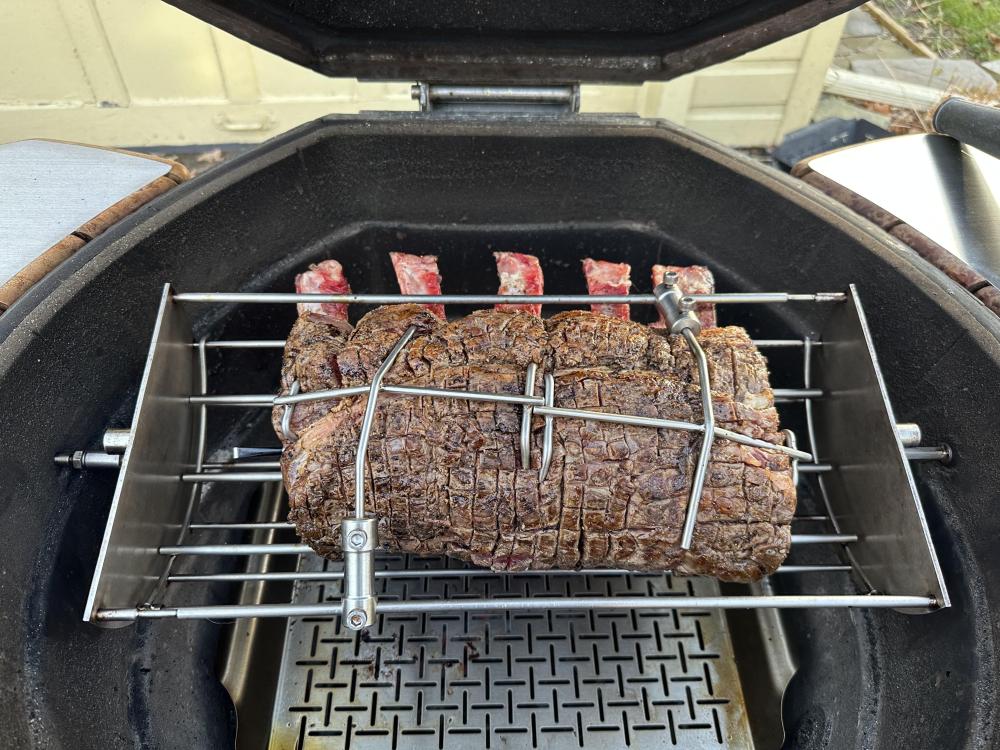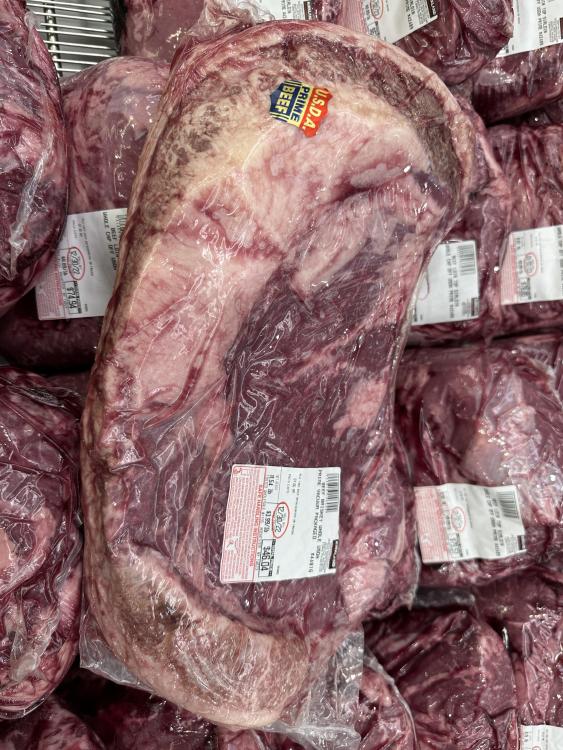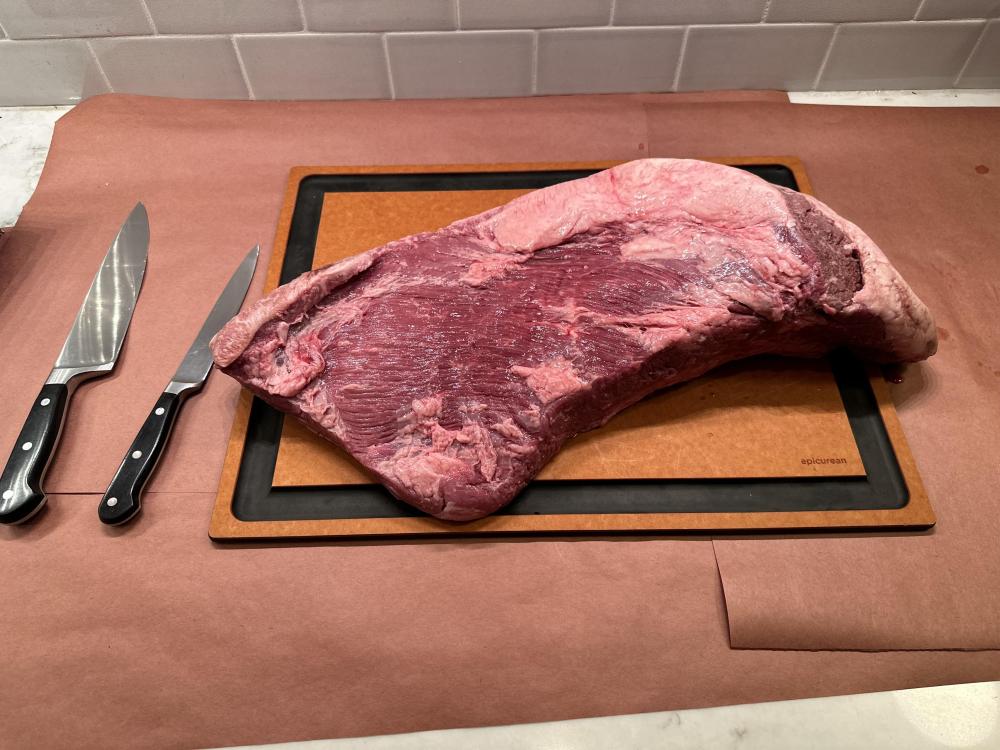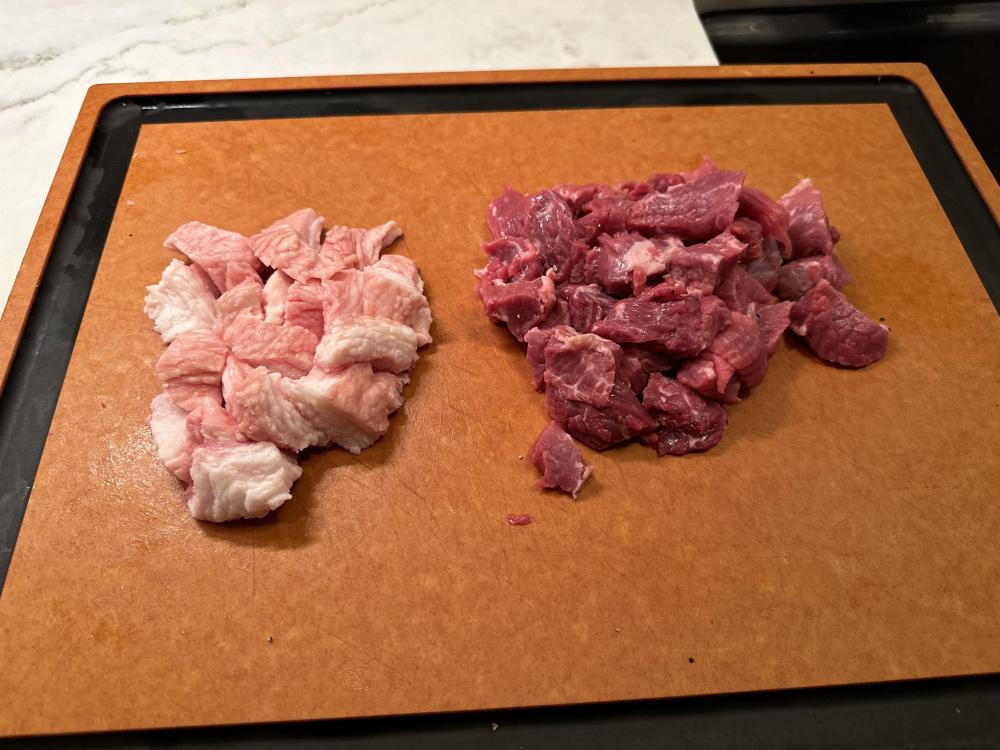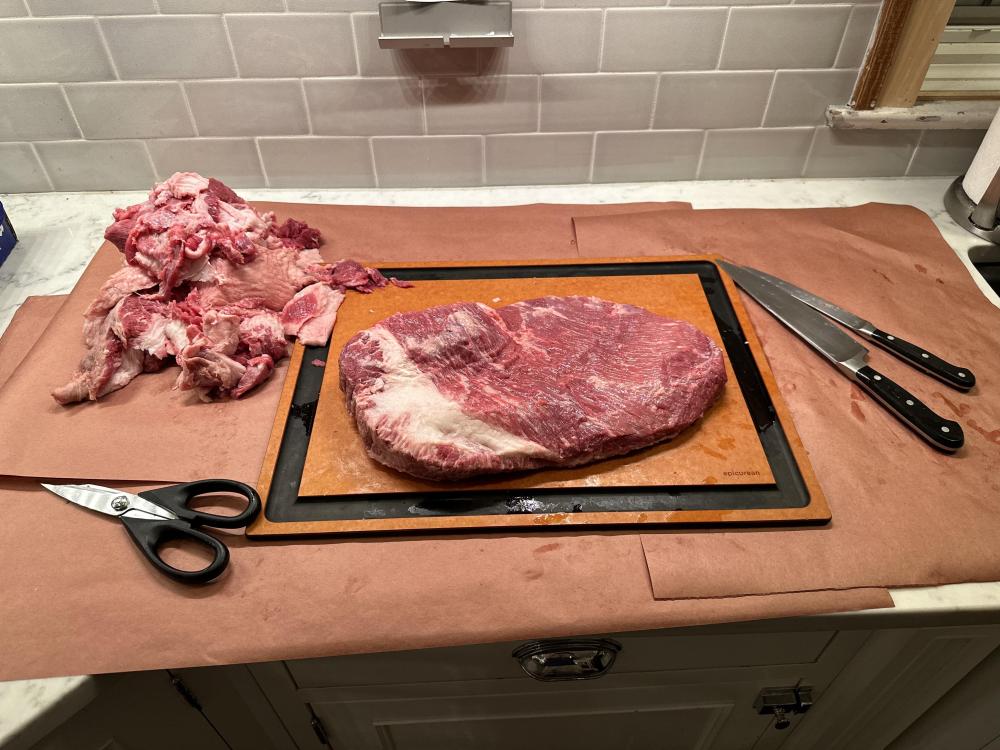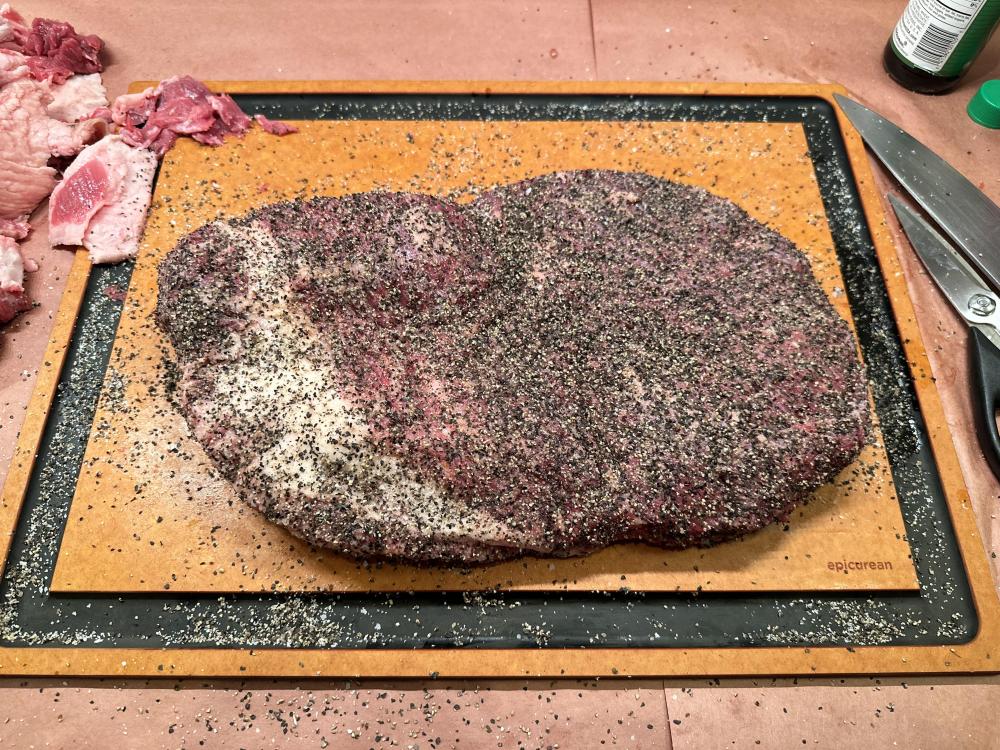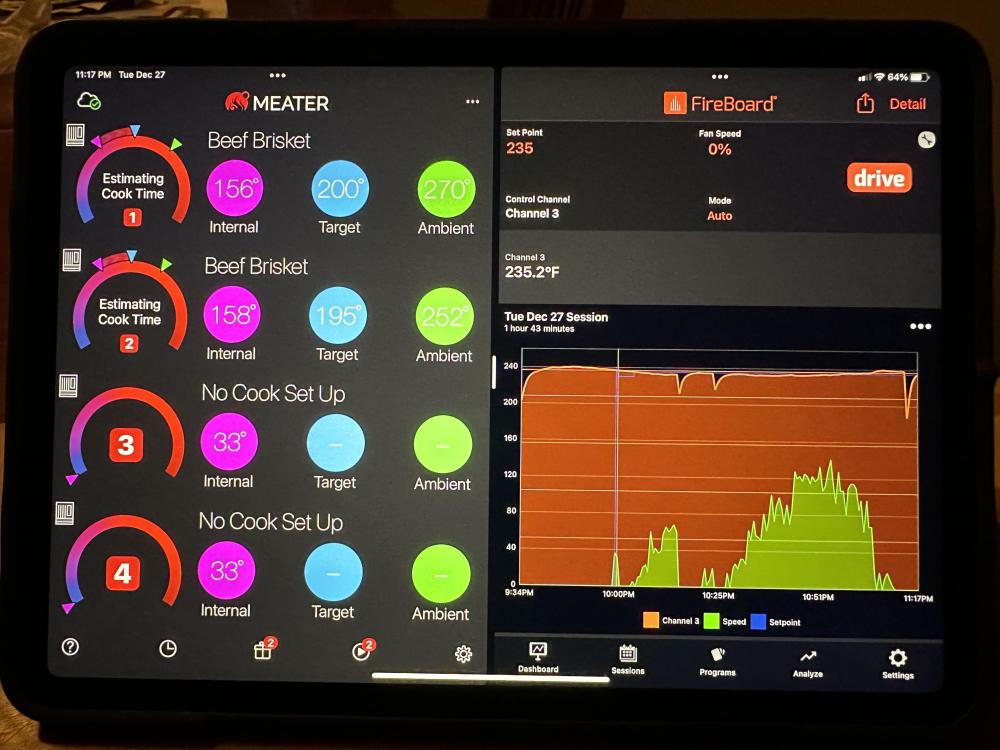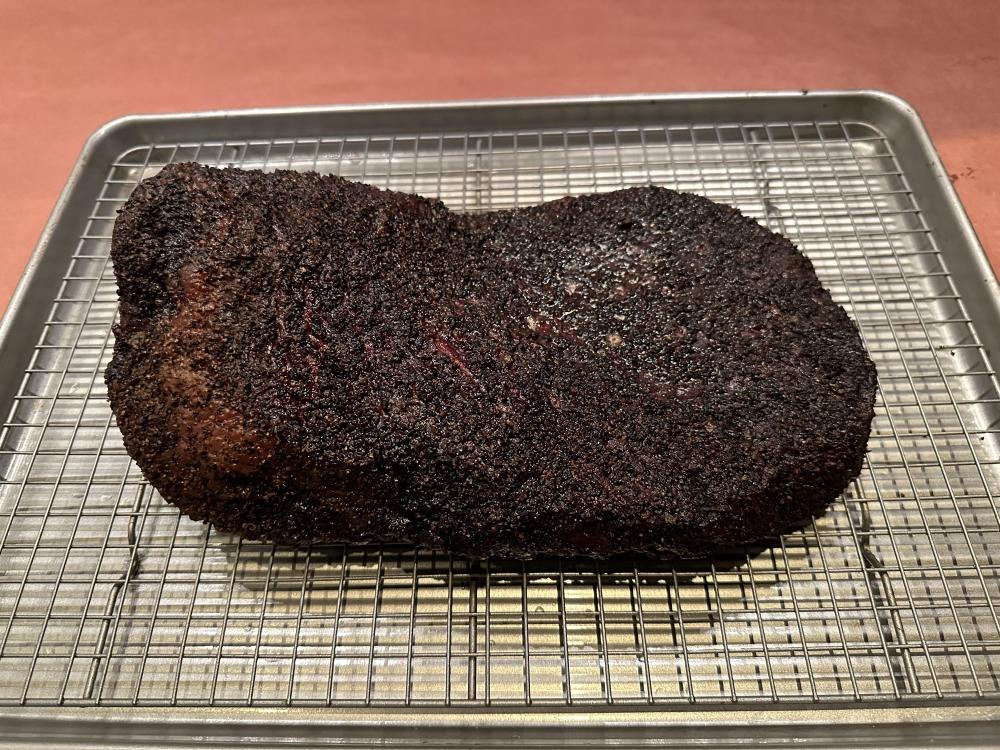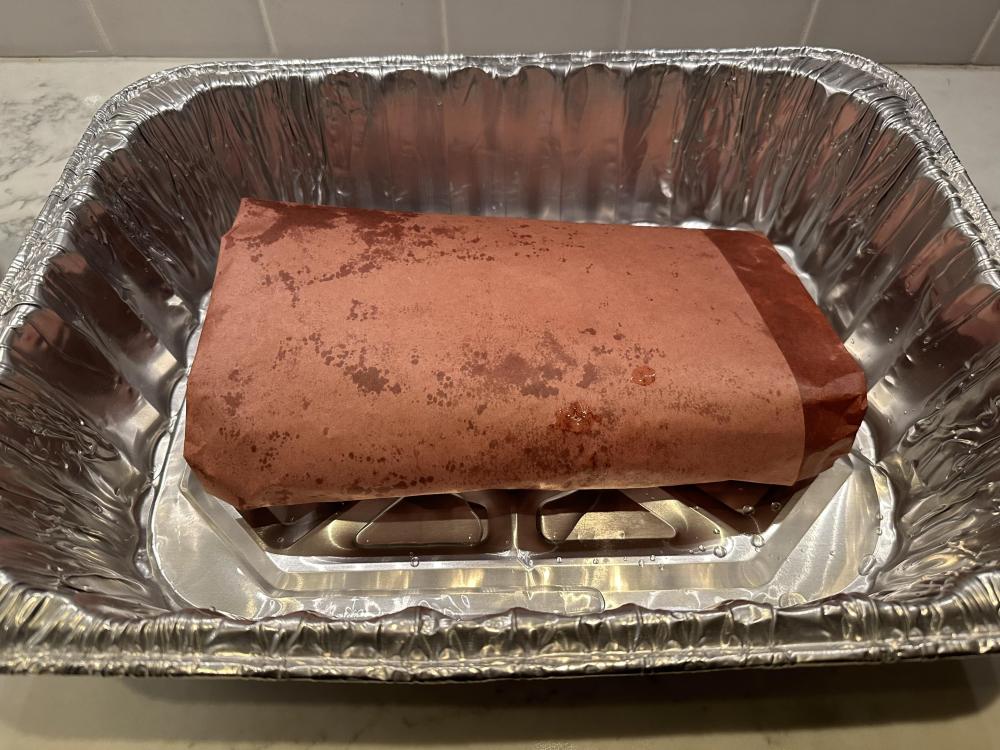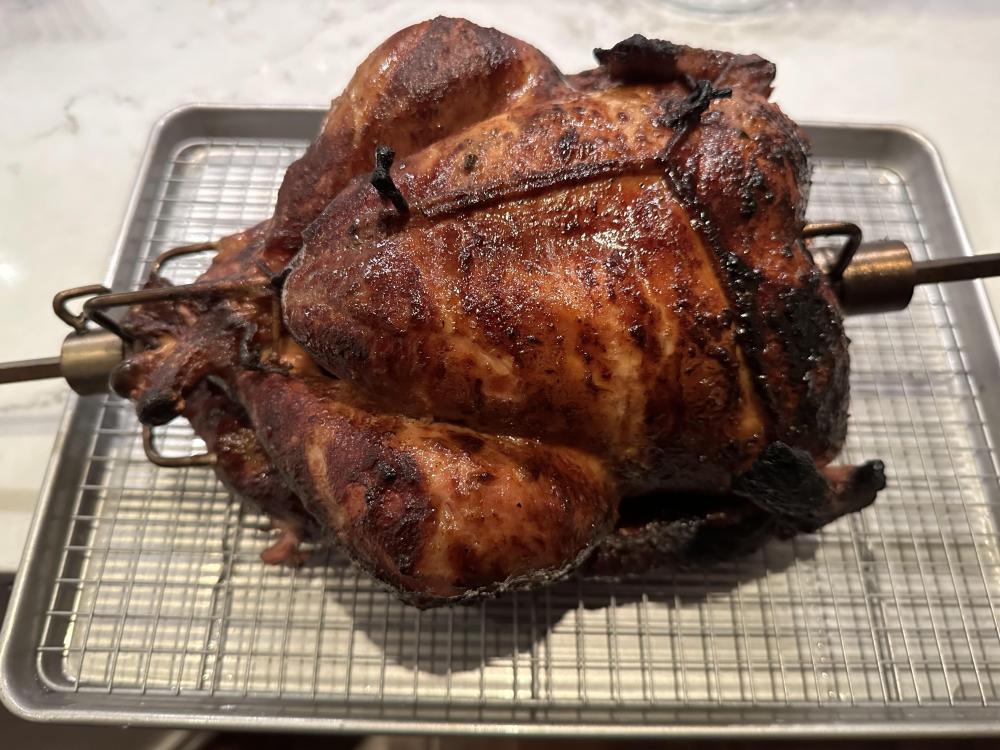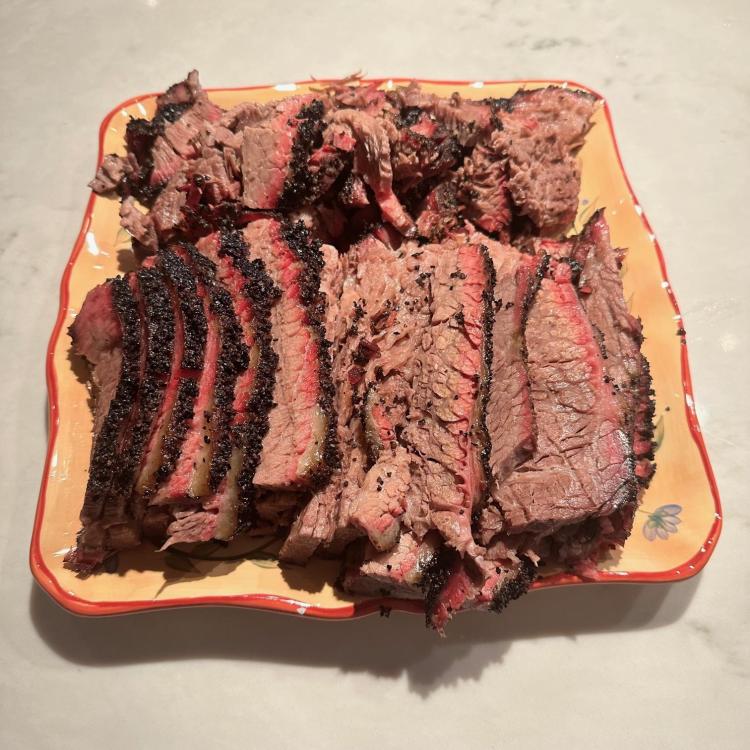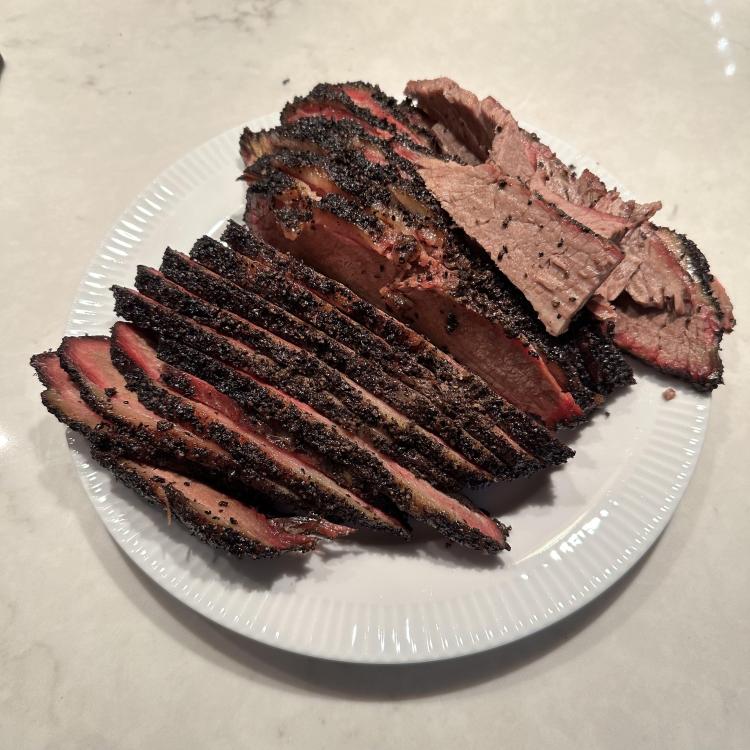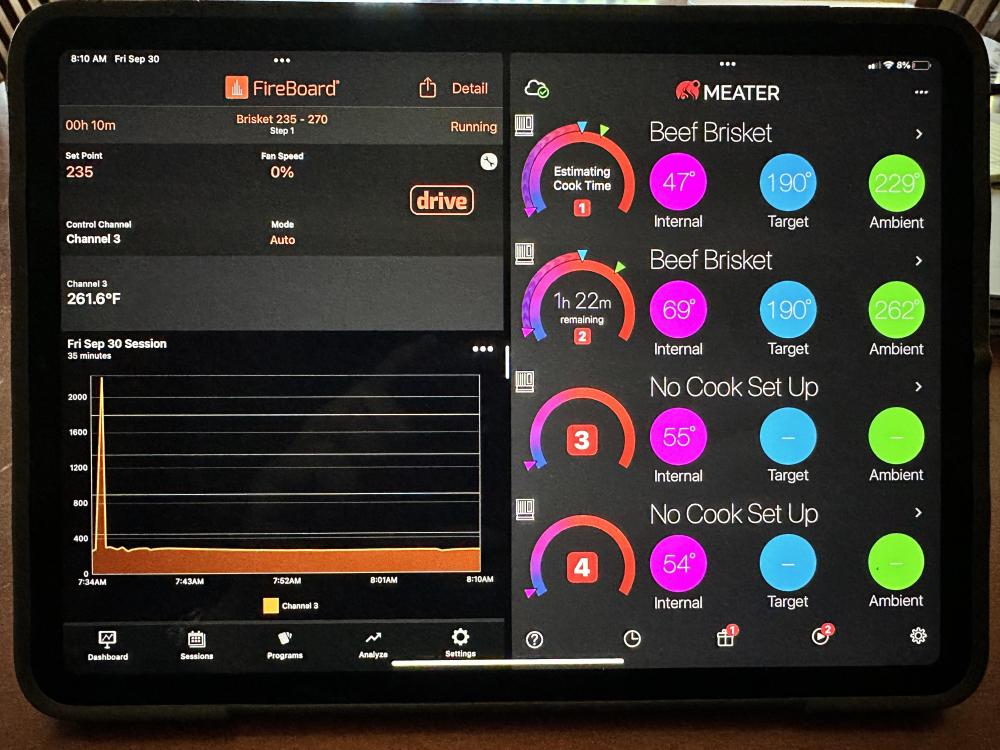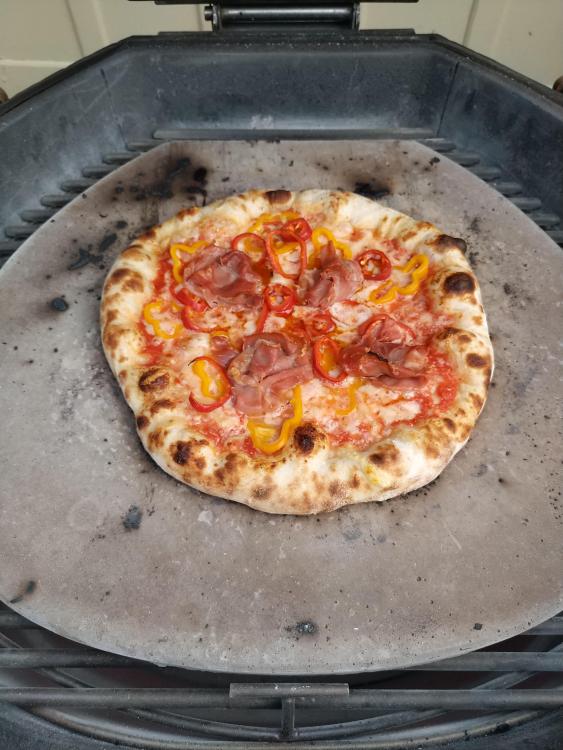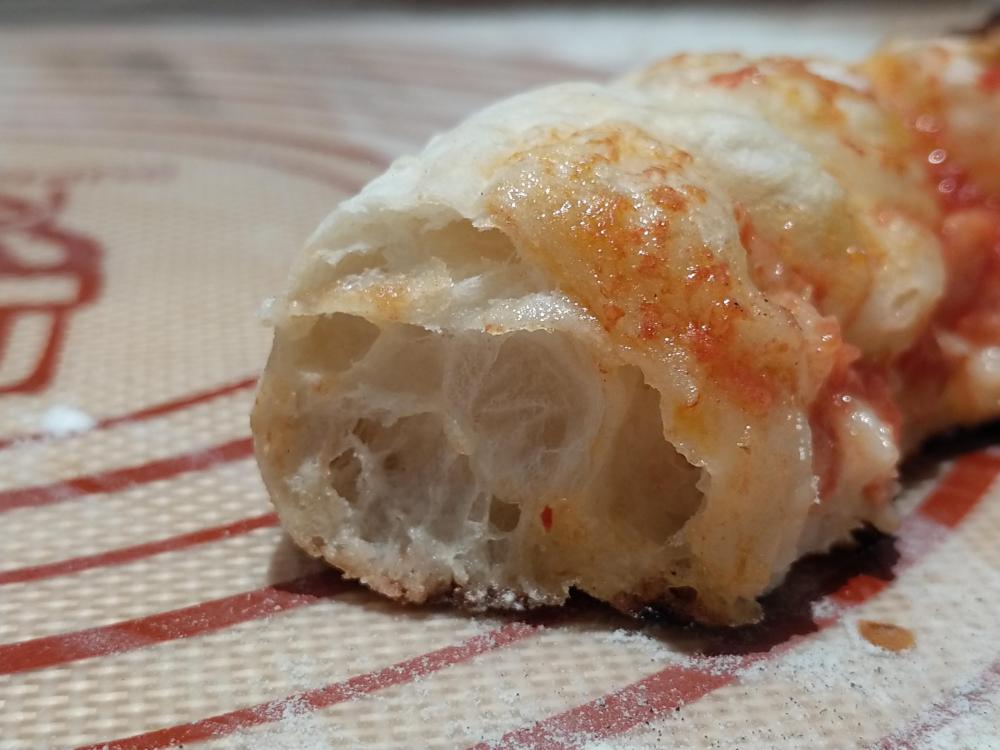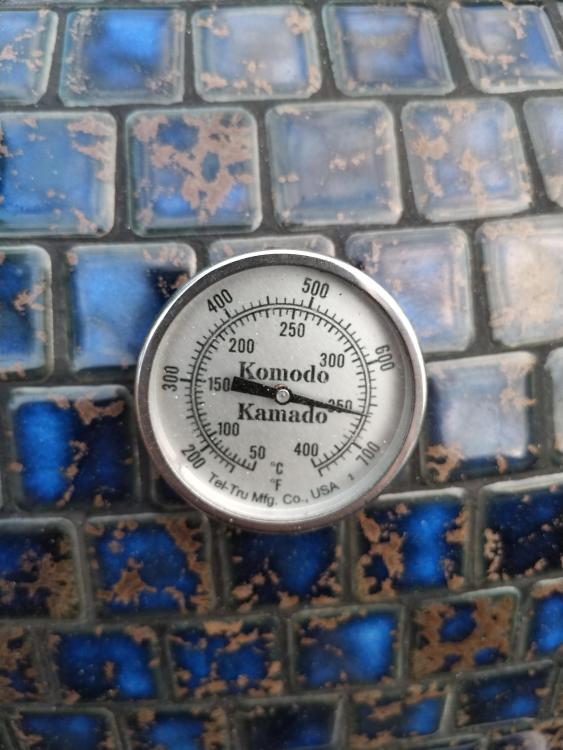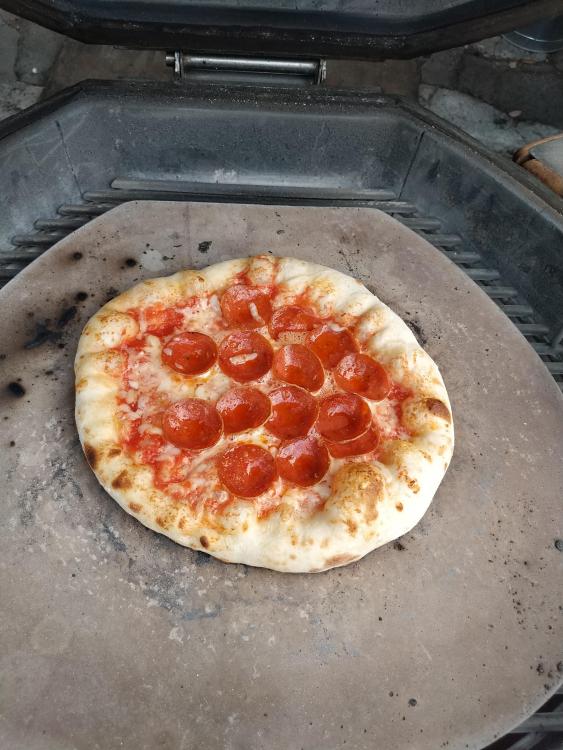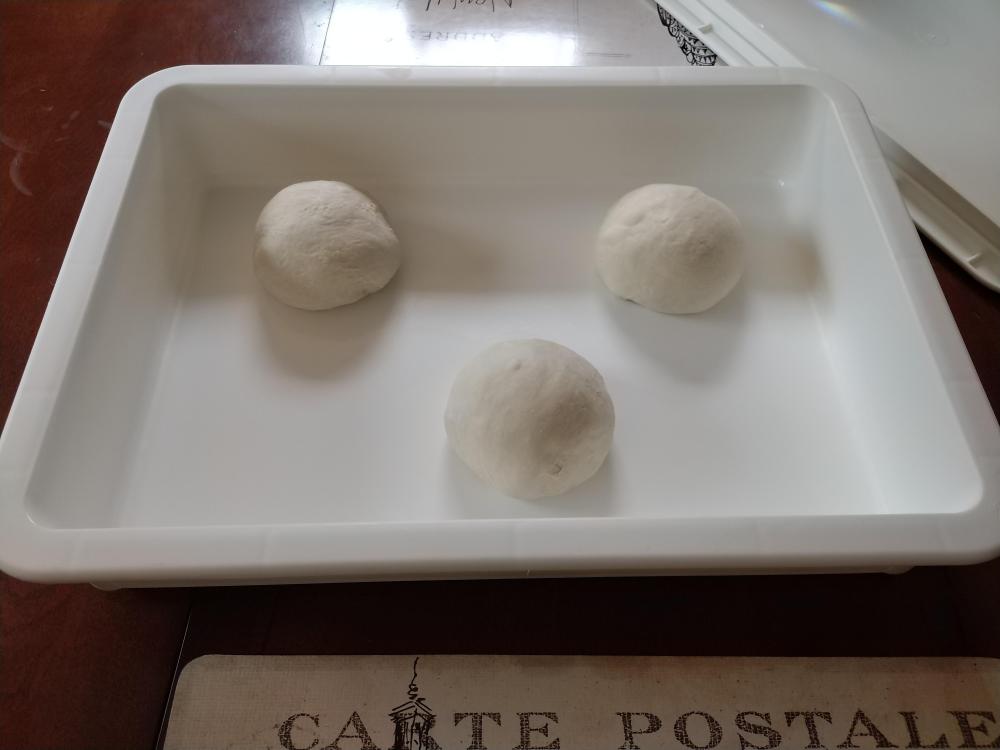
KK787
Members-
Posts
47 -
Joined
-
Last visited
-
Days Won
4
Content Type
Profiles
Forums
Events
Everything posted by KK787
-
New Pulled Pork Technique - Tested - Game Changer - Video
KK787 replied to KK787's topic in KK Cooking
Great info Tony! Will give that a try my next time around. The interesting thing is you can render the leaf lard, smoke it, the return it to the original container for safe keeping. That cold smoker is next on my list of things to buy. How long do you smoke the lard/tallow for? I will say this was the smokiest - in a good way - pulled pork I ever tasted. And lots of bark - it was a really good balance. I dry brined with a good coating of salt and pepper and followed through the next morning with Meat Church VooDoo and Honey Hog on 3 pieces each - hence, two separate bowls. -
New Pulled Pork Technique - Tested - Game Changer - Video
KK787 replied to KK787's topic in KK Cooking
I am not sure. We made a homemade slaw that was heavy on the white onion that paired up really well with the pork. We didn’t use buns. Contact Jim via the comment section of the video. I’m sure he can help. -
Tried this new pulled pork technique with fantastic results. Smokey, moist without being watery, incredible flavor throughout so much so putting sauce on it wasn’t necessary. The video is below. I used 250 ambient temp at the meat. Once wrapped with Leaf Lard as per the video, increased temp to 300. Just follow the instructions in the video for the best pulled pork you’ve ever tasted.
-
Tried this new pulled pork technique with fantastic results. Smokey, moist without being watery, incredible flavor throughout so much so putting sauce on it wasn’t necessary. The video is below. I used 250 ambient temp at the meat. Once wrapped with Leaf Lard as per the video, increased temp to 300. Just follow the instructions in the video for the best pulled pork you’ve ever tasted.
-
Goldie’s BBQ Brisket Resting Technique = Excellent Results
KK787 replied to KK787's topic in KK Cooking
My design is pictured below but the Coleman Party Stacker looks way simpler. That’s what I would go with. As long as the there is enough room between Anova's minimum water level and the cover, it should work. My pan sits above the water level. I cut 4 pieces of 4 inch PVC - just high enough to allow air under the pan yet still above the minimum water height. I drilled large through-holes to accommodate water circulation. I use a remote temp probe above the water line and found that a water temp of 160 yields an air temp of 150. So be careful that you set your system based on internal air temp to avoid going below the safe food temp of 140. The holding cooler is a game changer. All of my briskets have come out excellent and I attribute this to the long, warm, moist rest which breaks down all of the collagen and inter muscular connective in a way other resting methods cannot. That’s why Franklins, Goldies, etc. use this method via Alto Shamm holding ovens - same principles. So when the point probes like butter, and even if the flat is still slightly firm, I pull it, wrap it as described above, and get it into the cooler and let the long rest tenderize the flat without overdoing the point. It’s a fine line. And if the rest is 12, 15, 20 hrs, the bottom line is the brisket will be perfect when your guests arrive. No more embarrassing guessing games and it frees up the cooker the next day for pulled pork, ribs, etc. Now be cautious. This works great with Prime cuts. If using Choice or Select cuts, do not exceed 15hrs - the word is you will get a tough flat. So just be cognizant of your cut and the time spent in a holding oven. -
Smoked a Costco Prime Brisket using Goldie’s resting method. Came out great. Here’s the basics. 1. Worcestershire Binder 2. Light sprinkle of Garlic Salt and Lawery's Seasoning Salt 3. Rub 2 to 1/2 Pepper to Salt 4. Dry Brine over night 5. Harry Soo’s Weber Smokey Mt wood/charcoal setup. If you are not using this, you are missing out. 6. Inject the flat with beef tallow 7. 250 degrees. No cruching, No spritzing. Threw fat scraps on my perforated heat deflector. Rendered fat = incredible flavor profile. 8. Pulled when the point probed like butter and the flat was 195 9. Goldie’s - foil wrap twice. Be sure to put a dig scoop of tallow under the point. Into a foil pan, 1/2 cup of water, foil cover over the pan. 10. Put into my Igloo Sous Vide warming cooler at 160 degrees for 22 hours. Brevel Toaster oven works too. Aggressive trimming and a long controlled rest key to a perfect brisket evert time.
- 15 replies
-
- 10
-

-

-
Check out Chuds BBQ video on this subject - I think it’s under his foil boat video. He uses with great success a Breville Toaster Oven for long rests because it has a digital panel and can go as low as 160 degrees - actually lower.. I think he rests for 10 hours. It’s not outrageously expensive either and can be used for many other things. I use a wet oven made from an Igloo cooler and a Sous Vide. Works great.
-
Inject with rendered beef tallow about every square inch. Works fantastic. Try a rub derived from Arron Franklin: 2 parts pepper, 1 part kosher salt, a sprinkle of Lawerys and course Garlic Powder directly on the meat. Lawerys is very salty so reduce 2 TBS if going that route. Also a few shakes of low sodium soy or worchishire (sp) rubbed into the meat makes a great binder while providing an excellent umami effect. Let sit in the refrigerator overnight uncovered - dry brining. The only other thing I would add is rest your brisket at room temp to 180 then wrap it in tallow soaked butcher paper, place in a foil pan with a 1/2 cup of water, and cover tightly with foil. Place in a cooler on 2 bricks. Add 180 degree water to the cooler and rest for 4-6 hours or even up to ten. Change the water if it gets below 160 by opening up the drain plug then adding more water. The moist rest is the game changer. Or wrap in foil place in a Brevelle Toaster Oven for 6-10 hours at 160 (Chuds BBQ) - excellent results.
-
This is my second dry-aged prime grade Prime Rib I’ve cooked on a 23 Ultimate with outstanding results. I am here to teach you how I achieved a roast with excellent crust, pink throughout - no dark overdone perimeter ring, and excellent flavor, and the tools I used. SOURCES: Adam Perry Lang book: Charred and Scruffed Thermoworks Video: Prime Rib Tutorial TOOLS KK 23 Ultimate or Similar KK Rotisserie Basket KK lower grill grate Weber Stainless Steel Grill Pan (Rectangular & Perforated) Jealous Devil Lump Charcoal Fat scraps from the trimmings Butcher String OPTIONAL TOOLS Meater Probe PROCEDURE THE ROAST: Find a Prime Rib of your liking. We used a Prime Dry-aged 5 bone roast. This is expensive but worth every penny. Have the butcher take the roast from the thicker side of the cut, cut the bones off, then tie the roast together. TRIM: Remove the butcher string. Trim away the majority of the fat and silver skin so the rub has plenty of meat to stick to. This will lay the ground work for a beautiful flavorful crust. I trimmed using French Style by trimming off the thick fat cap on top of the bones then trimming in between. SCRUFF: Charred and Scuffed - absolute game changer in the way I grill and roast. Adam’s techniques will elevate your steaks, poultry, roast, etc. to whole new level. Scruff and rough up that meat surface. You can achieve this in several ways. I chose to make shallow surface cuts. RUB: Charred and Scuffed seasoning rub: 1 cup kosher salt, 2 TBS fresh ground black pepper, 1 tsp garlic salt, 1/2 tsp cayenne pepper. Grind in a spice grinder/coffee grinder/food processor until a sand consistency. Use a few splashes of low sodium soy sauce as a binder. Coat the roast heavily with the rub, moisten hands, and really work it into the scruffed surface. I added more pepper directly and worked it in. Season between the bones and roast. Use butcher string to tie the roast back together. Refrigerate overnight uncovered. ROOM TEMPERATURE/FREEZE: Pull the roast from the fridge and bring to room temp - about two hours. Then, put the roast into the freezer for about an hour until the outer 1/4 or so is almost frozen. This will keep the outer portion of the roast from turning brown and produce a rare color edge to edge. LIGHTOFF: Light your KK and set up for a 225-250 meat level cook - about 250-300 at the dome. Make sure it’s preheated in cold environments. Connect your rotisserie motor and ensure your basket fits. Install the lower grill grate. 15 minutes before go time, fire up your gas grill or similar and preheat your pan for the initial sear. WEBER DRIP PAN - GENIUS: I started using this by my own accord and have had phenomenal results. Place the Weber Stainless Steel Grill Pan centered on the grate. This works as an excellent heat deflector. Better yet, the pan's perforations allows the fat renderings to drip through and reach the fire creating a beautiful smoke that adds incredible flavor to the meat. SEAR: Sear the roast on all sides for roughly 15 seconds on each portion. I use a gas grill, cast iron griddle with beef tallow on high heat. LOCK & LOAD: Load the roast into the basket and lock it in secure. I use three MEATER probes, two in the ends and one in the center. I use the two end probes to measure the ambient temperature at the roast. The middle probe is placed in the thickest part of the roast and set to 125 rare. Meater is purely optional. TURN ON THE ROTISSERIE: Make sure everything works properly. ADD THE FAT: Take some of the white fat scraps from the trimmings and toss them onto the heat deflector a few times during the cook. The fat will slowly render and drip into the fire below creating a smoke that adds another dimension of flavor to the cook. BASTE: Baste the roast very 20-30 minutes. I use one cup olive oil, one stick of unsalted butter, some thyme sprigs, one mashed garlic clove, chopped rosemary, and a few shakes of low sodium say sauce. Simmer for about 5 minutes and set aside. I use an herb mop made by bunching sage, rosemary, thyme, etc all bunched together and tightly tied with butcher string. COOK: My 10 pound roast cooked in 2.5 hours - much faster than the 4 to 5 hour oven estimate - when my center meter probe reached 125 degrees. The other portions read 134 with the thinnest part reading 140. I backed the temps up with a Thermopen. Bottom line, everyone was happy - something for everyone! REMOVE: Remove the roast and let sit for 40 minutes. SAUCE: Prepare a finishing sauce of olive oil, chopped large leaf parsley, garlic, salt and pepper. Chop the roasted ends of the herb mop and add to the mixture. Drizzle over the meat once carved. CARVE: Carve and serve. I like to put the sauce on the cutting board, slice my slab into pieces and tossing with the board oil mixing the meat juices and sauce all together. Plate and finish with an additional drizzle of board oil, a thyme sprig - incredible flavor. ENJOY!! Final note, this was the most flavorful prime rib I’ve ever had. The "Scruffed" process give the roast an incredible flavor that penetrates the surface much better than just adding seasoning to the surface alone. That combined with the smoke produced from the fat renderings, the finishing sauce, makes for a delicious combination. A special thank you to Adam Perry Lang who revolutionized the Scruffed process - it’s a game changer for chops and steaks as well. Also, a huge call out to Dennis for is input and excellent customer service. Happy New Years to all.
- 1 reply
-
- 4
-

-
THE PERFECT BRISKET - TAKE 2 - TUTORIAL His is my second post in regard to smoking the perfect brisket on a KK. This is my second brisket where I achieved phenomenal results. The bend/pull tests, perfect. Flavor, exceptional. Moist Flat. How did I do this? I attribute my success to studying what the pros do - the guys that do this for a living and/or who’ve won hundreds of competitions. So sit back, I’ll share my sources, and teach you what I did. All the sources can be found on YouTube. SOURCES MadScientist BBQ - 12 Brisket Mistakes To Avoid MadScientist BBQ - How To Trim a Brisket MadScientist BBQ - I Was Wrong - explains how to use WHITE smoke to your advantage. MadScientist BBQ - Secret Revealed - Explains the importance of using old school moisture and Fat to Enhance flavor. SlapYoDaddy BBQ - Harry Soo - How to set up a Weber Smokey Mt Smoker. Works perfect in a KK. No Kettle pots needed. Chuds BBQ - do a YouTube search for brisket - great info. TOOLS KK Grill or similar KK Upper and Lower grill grates Weber Stainless Steel Roasting Pan - Rectangular Weber Stainless Steel Roasting Basket - Square OPTIONAL Fireboard Controller - Controls the fan BBQ GURU Pit Bull 25 CFM Fan with adjustable dampener MEATER Block Probe or equivelent Meat Injector Water Resting Cooler - 12 Hour Rest PROCEDURE 1. MEAT: Find the best brisket you can afford. For this cook, I stumbled into a lone rouge 10.5 pound Prime brisket in Costco - they have been out for over a year. Snagged it immediately. 2. TRIM: TRIM TRIM TRIM. Absolutely the most important part. This brisket had a lot of thick fat that had to be removed. The Point muscle the was long and thin. The outer Flat was fairly thin too. MadScientist BBQ above takes you through the process - heed his advice. I ended up trimming roughly 3+ pounds of fat and meat that would otherwise be a mushy, dry, tough mess. 3. RUB: Basic Rub = 2 parts 16 Mesh Pepper to 1 part course Kosher Salt. Optional: Use a few shakes of Low Sodium Soy as a binder. Gives an excellent umami quality to the cook. Lightly sprinkle Lawery's Seasoning salt onto the brisket. Definitely go very light. Lightly sprinkle Course Garlic Powder onto the brisket. Generously coat your brisket with the salt/pepper base. Go heavy here because this is what gives you the coveted black flavorful bark. You can stop here if you like. If you go with the options listed above, reduce the salt by a tablespoon or more per cup of rub to keep the overall saltiness in check. 4. INJECT: Inject the flat every inch or so with rendered beef tallow. This works wonders and prevents a dry flat. Not totally necessary but helpful. 5. REFRIGERATE: Overnight 6. PLAN: Plan your cook. I shoot for about 1:20/lb. I then plan on a 10 - 12 hour rest. If the rest is a little longer or shorter, no big deal. Really makes having it ready for company easy. More on the Rest below. 7. FIRE: Award Winning Harry Soo's Smokey Mt. fire technique works perfect in the KK and produces hours of beautiful clean smoke. No kettle pots or foil pouches needed. This is a total game changer. I used a combination of apple and hickory wood chunks. Follow is technique to a T. 8. WEBER HEAT DEFLECTOR: Game Changer. Wanting to get rendered fat to the fire, I found these and put them to work. I used two for this cook. The square Weber Roasting Basket fits perfectly resting on the fire basket handles over the fire. Once in place, install the lower grill grate and center the rectangular Weber Roasting Pan directly under where the brisket will sit above. This pan fits under the brisket perfectly (you can also use either or as a single deflector sitting on the fire basket handles). Once in places, install the upper KK grate. The beauty of using the two perforated deflectors is it gives a nice balance of heat/smoke around and through the perforations and the fire burns a little hotter which gives you cleaner smoke. It also allows fat renderings to penetrate the perforations and reach the fire which gives incredible flavor to the brisket. Fat on the fire is an “Oldtimers" secret. 9. TEMPERATURE: Shoot for 235-260 at meat level. If your fire gets away from you, dowse it with some water to get it back in check. A 250 dome temp with the two heat deflectors is a safe bet. If no electronics, skip to #12 below. 10. ELECTRONICS: I was doing an overnight cook and didn’t want to wake up to a charred piece of leather brisket so I used a Fire Board, MEATER probes, and Fan to keep me safe. - Install 2 MEATER Probes - one in the center point and the other in the center flat. - Open MEATER/Fireboard Apps. Set up MEATER cook. I set my internal temps to 200/195. - Install the fan into the KK fan receptacle, open the fan dampener to 1/2, connect to the Fireboard Controller, close the KK bottom vents. The Fan dampener opening is now your new vent. - Install the Fireboard Temp probe via the KK receptacle. - You are ready to cook. 11. THE BIG TRICK - THE FAN DAMPENER: Once the meat is on, if the temp is increasing and the top vent is set correctly, it could be the fan dampener is allowing to much air in with the fan at idle so you may have to close the dampener opening from 1/2 to 3/4 to prevent a raging fire. Ideally, you want a fire that is gradually decreasing to the set temperature so the fan is required to engage every so often to keep the temps constant. If the dampener is open to much, the fire could gradually increase and the fan will never engage and things unravel from there. 12. THE COOK: Place the cold brisket over the drip pan. I also add a small water pan as discussed previously. MadScientist BBQ did a whole video on this. It works great for me. If you prefer otherwise, cool. Open the upper grate swing door and throw a few pieces of fat scraps onto the upper drip pan for incredible smoke and flavor. Close the lid. After a few hours, some tallow pooled on the flat which I blotted off. Add a few more fat scraps. Spritz a few times if you like with water/apple cider vinegar. No cruching. No wrapping. That’s it. 9 hours later, MEATER Alert at 195 point, 190 flat. 13. IGNORE THE TEMPS: It’s all feel at this point. Probe the meat with a Thermopen. My point was butter soft. The flat, still a little stiff. Although the 12 hour Sous Vide water chest rest might correct this, I’ve learned to go with feel. I ended up allowing the flat temp to increase to 206 where it really softened up and the point was still butter smooth. The 12 hour rest would finish it off. 14. THE REST: The Holy Grail! By far, the rest is the second most important part with trimming being first. MadScientist BBQ and Chuds BBQ have excellent videos on this - see 12 Brisket Mistakes above. A long rest is extremely important. Follow safe food temp guild lines. I made a water oven from an Igloo cooler and a Sous Vide. I set the resting temp to 160. Pull the brisket from the KK. Let cool until about 180. Wrap tightly in tallow coated butcher paper. Place into an aluminum pan, add 1/2 cup of water, cover tightly with foil, put in the cooler, and forgetabodit for 10-12 hours. You can improvise by placing two warm bricks in a cooler, put the foil pan on the bricks, add 170 degree water, close tightly. Drain the water every 3-4 hours via the drain plug and add more 170 degree water. Just an idea. 15. EAT: ENJOY!!
-
- 5
-

-
Forgot to mention a great French Chef technique …….. after pulling your bird from the refrigerator, put ice packs on the breast meat while the rest of the bird comes to room temp. This will ensure your dark meat finishes in the 185 - 190 range as the breast hits the 170s while maintaining a consistent skin doneness all around. . The dark meat connective tissue at renders at about 180. Anything below that temp the dark meat could be a bit tough.
-
You were ahead of your time Tony!! It’s really cool watching Kickstarter projects come to fruition. In my Perfect Prime Prime Rib rotisserie post, the Meater saved the day. I estimated the cook to be around 4+ hours. I used all four probes and an hour into the cook, Meater estimated the cook was going to be done in 1.5 hours - an hour and a half early. I was in disbelief. So I pulled out the thermopen and confirmed the temps bingo, the roast finished an hour and a half early. The KK with hits huge heat retention just cooks things faster. But without the Meater, I would have had an overdone roast. Thanks Tony - have a great holiday season.
-
Thanks!! Give it a try and have a great holiday season.
-
After a lot of research, trial and error, great talks with Dennis, I’ve unlocked some secrets to the perfect rotisserie Turkey. 1. Brine: 1 gal of water. 1/2 cup of kosher salt. 1/4 cup brown sugar. That’s it. Nothing more. Top chefs I’ve talked to, that’s all they use and all that is needed. Brine for 24 hours. Double recipe if needed. 2. Baking Powder: It must NOT contain aluminum. Pat dry the bird after brining. Use a fine mesh sieve and dust the entire bird. This works great for crisping up the skin and also works great on chicken wings too 👍. 3. Air Dry: Air dry the bird 24 hours uncovered in the refrigerator. Bring to room temp about an hour before the fire. 4. Drainage: Use a Jacard meat tenderizer or knife to make small slits in the skin in fatty areas to drain rendered fat. This will allow rendered fat to drain, fall into the hot coals and smoke which will give your bird absolutely incredible flavor. 5. Truss: Truss the bird and Install the skewer directly through the center of bird. Use the skewer point and a hammer to pierce the cartilage making sure it is evenly placed through the center. 6. Fire: 375-400 at the dome. Preheat at least one hour in cold temps. Add 2 cherry wood chunks to the fire about an hour into the cook - gives nice subtle hint of smoke and adds nice color to the bird. 7. BIG SECRET-Heat deflector: This is a game changer I discovered. Use a Weber stainless steel perforated roasting pan as your heat deflector. The square one fits perfectly between the handles on a 23 Ultimate. See picture below. This deflects the heat, but most importantly, allows renderings from the bird to drain through and reach the fire which adds incredible flavor to the bird. Better yet, the pan blocks all flareups from reaching the bird. 8. Baste Recipe: Roast the bird for 1 hour. Prepare a baste consisting of 1 cup olive oil, one stick of butter, chop thyme, rosemary, chive, sage - add to oil. Purée’ a shallot, and mash two garlic cloves - add to oil. Salt and pepper to taste. Heat on low and combine. 9. Basting Mop: Take a small bunch of thyme, rosemary, and sage stalks and tie them up super tight with twine twice at the end making a mop. Stir and saturate in the basting oil. Remove basting oil from heat. 10. Baste: Baste the bird every 20-30 minutes after the first hour. The basting oil will drip into the hot fire again creating incredible flavor. The oil will also help crisp up the skin. 11. Temp: 170-175 breast and 185 dark meat. Generally, white meat finishes first. As the white meat approaches its finish temp, I stop the rotisserie so the dark meat is facing the fire and I hold this until the dark meat hits the indicated temps. Do this when the white meat is about 165+ for about 15 minutes. The connective tissues in dark meat will not render until about 180-185. If you go above to 190, no big deal. The higher the better. 12. Scorch: Turn the rotisserie back on. Bring the fire up to 500 and finish for 5 minutes. This will give the bird its final color and crisp it up. 13. Remove the bird. Let rest for 15-45 minutes - I find that 30+ works best. Carve and enjoy. 14. Meater Probe: These work fantastic with no wires and really changes the rotisserie game. You get internal temps and external temps directly at the pint of the cook and the software interface is really nice. The estimated cook times get you close in terms of internal temps but use a Thermopen to spot check around the bird to fine tune. This is the very best turkey all of my guests including a professional chef has ever tasted. My neighbors texted me and I found them hovering around the grill waiting for samples 😂. Been asked to do a demo for a local William Sanoma store. It’s incredibly flavorful throughout. The white meat is moist without being watery or salty and has incredible grilled flavor. The dark meat is succulent - absolutely delicious. The key is the perforated heat deflector - it is truly a game changer - Enjoy!
-
From what I have experienced and read, when fat burns on a solid surface at a lower temp than an actual flame, it’s sticky and mucky and may produce a burnt smell profile. When fat hits hot flames it produces a white smoke that actually enhances the taste of the meat. Many offset pit masters are tossing their soft fat scraps into their pits to achieve this effect. It’s sort like the taste of burnt scraps on a griddle vs the flame taste of a burger done on open flame. The open flame flavor is achieved by fat drippings hitting the open hot flames. This works especially well when doing rotisserie chickens and turkeys on the kk. Try my Weber perforated pan technique - it prevents flareups while allowing the rendered fat to hit the hot flames which produces a beautiful white/blue smoke that really enhances the flavor of the meat.
-
Accidentally pasted post - disregard
-
I’ve cooked other things and have applied lessons learned to this cook as well. The 15 hour wet oven rest worked great. Harry Soo’s method of wood use - excellent - have used it for many cooks - much easier and way better smoke than the kettle method used by 99% of the people here as stated in another post. The use of a little water keeps my drip pan from burning fat which is a flavor I did not desire to have for this particular cook. Two or three spritzes during a 9 hour cook helps prevent an overdone bark - what’s the big woop? I do what is needed for a particular cook. My next brisket, I will try my weber heat deflector trick which will allow rendered fat to reach the fire and see what taste profile that yields. I chuckle when I here 99% of the people here don’t do that. There are so many new techniques being discovered out there. I certainly hope the 99% don’t miss out.
-
Thanks for your reply’s. Mad Scientist BBQ did the white smoke research based on his own testing and secrets shared from other pit masters he works with. Dennis also agrees their findings. Other cooks that use Komodo style grills (smoking dad bbq) have done blind tests where they found spritzing and a water pan improved their results. Adding water also keeps my drip pan from burning. I've been pleased with the results with beef ribs and pork butts. For chicken and turkeys, I use a square perforated Weber roasting pan as a heat deflector. It fits perfectly between the coal basket handles on a 23. It deflects enough heat and allows the rendered fat to reach the fire which gives incredible flavor to poultry. The meat was a Costco Prime and yes, 5 pounds was trimmed off a 15 pound brisket.
-
After about a years worth of research, advice from Dennis, I smoked my first prime brisket on a 23 Ultimate. The results were outstanding. Rub - 2 to 1 Pepper to salt. Before mixing, I subtracted 1 TBS of salt. Rub applied liberally. Then lightly sprinkled with Lawerys followed by garlic powder. Dry brined in the refrigerator uncovered for 24 hrs. Fuel - Jealous Devil, hickory and cherry wood chunks at the bottom. Harry Soo’s method. Drip pan with water and spritzed with apple cider/water combo 3 to 4 times. Rumor has it it’s not needed, latest scientific info says it essential. Once eye burning smoke cleared to white smoke (10 minutes) placed cold brisket onto cold grill. Turned Blue in 1hr. Not all white smoke is bad - latest finding. 15lb brisket trimmed down to 10lb, smoked 9 hours at 230 Meater probe temp increasing to 250. FireBoard controlled the fan. Meater used to monitor the meat. Pulled at 190. Wrapped in tallow/butcher paper. Rest 15 hours in a wet oven/cooler. Done.
-
Looking for some advice on smoking my first brisket. I’ve concentrated my attention on Harry Soo and Smoking Dad BBQ. Harry dominates competitions on the Weber SmokeyMountain while SD has good info on the Komodo style grills. Harry Soo …… I’ve set my KK up using his fire basket method for pork butts. I’ve achieved awesome blue smoke for several hours with no kettle pots or foil pouches. His method works fantastic. Here is a link: https://www.youtube.com/watch?v=dOctn85Y-n Harry also recommends using 275 with a simple heat deflector. I know the WSM doesn’t produce as much radiant heat but what temp do you recommend for briskets? SD BBQ technique with his Kamado Joe uses two deflector plates in order to run a hotter fire for better smoke at 300. It seems to keep the bottom of the brisket from getting tough. He also uses a technique where he puts wood chips in through the ash tray door so he doesn’t have to disassembled his system mid cook. Question: 1. Use 2 deflectors or 1? If 1, position it it high or low? I have the double drip pan, round drip pan, and pizza stone that can be used. 2. Temp for best results? 3. I have a newer Kk with the rear gas burner insert door panel that I can put wood chips or chunks in to augment the smoke with out moving everything off. Has anyone tried this technique? Thanks for your help👍👍 SD BBQ technique with his Kamado Joe uses two deflector plates in order to run a hotter fire for better smoke at 300. It seems to keep the bottom of the brisket from getting tough. He also uses a technique where he puts wood chips in through the ash tray door so he doesn’t have to disassembled his system mid cook. Question: 1. Use 2 deflectors or 1? If 1, position it it high or low? I have the double drip pan, round drip pan, and pizza stone that can be used. 2. Temp for best results? 3. I have a newer Kk with the rear has insert door panel that I can put wood chips or chunks in to augment the smoke with out moving everything off. Have you tried this or know anyone who has? Harry Soo …… I’ve set my KK up using his fire basket method for pork butts. I’ve achieved awesome blue smoke for several hours with no kettle pots or foil pouches. His method works fantastic. Here is Harry also recommends using 275 with a simple heat deflector. I know the WSM doesn’t produce as much radiant heat but what do you recommend for briskets? SD BBQ technique with his Kamado Joe uses two deflector plates in order to run a hotter fire for better smoke at 300. It seems to keep the bottom of the brisket from getting tough. He also uses a technique where he puts wood chips in through the ash tray door so he doesn’t have to disassembled his system mid cook. Hi Dennis ……. Looking for some advice on smoking my first brisket. I’ve concentrated my attention on Harry Soo and Smoking Dad BBQ. Harry dominates competitions on the Weber SmokeyMountain while SD has good info on the Komodo style grills. Harry Soo …… I’ve set my KK up using his fire basket method for pork butts. I’ve achieved awesome blue smoke for several hours with no kettle pots or foil pouches. His method works Harry also recommends using 275 with a simple heat deflector. I know the WSM doesn’t produce as much radiant heat but what do you recommend for briskets? SD BBQ technique with his Kamado Joe uses two deflector plates in order to run a hotter fire for better smoke at 300. It seems to keep the bottom of the brisket from getting tough. He also uses a technique where he puts wood chips in through the ash tray door so he doesn’t have to disassembled his system mid cook. Question: 1. Use 2 deflectors or 1? If 1, position it it high or low? I have the double drip pan, round drip pan, and pizza stone that can be used. 2. Temp for best results? 3. I have a newer Kk with the rear has insert door panel that I can put wood chips or chunks in to augment the smoke with out moving everything off. Have you tried this or know anyone who has? Thanks Dennis - appreciate your advice. Question: 1. Use 2 deflectors or 1? If 1, position it it high or low? I have the double drip pan, round drip pan, and pizza stone that can be used. 2. Temp for best results? 3. I have a newer Kk with the rear has insert door panel that I can put wood chips or chunks in to augment the smoke with out moving everything off. Have you tried this or know anyone who has? Thanks Dennis - appreciate your advice.
-
Stadlermade makes a small steel wood fired pizza oven that looks good. A traditional oven is nice but as stated above, they take a long time and lots of fuel to bring up to temp. The KK works great at these temps - no issues to report.
-
Thanks for the reply!! I used Caputo Blue for the pizzas above. I will crank up the KK to 800 and give it a try👍👍
-
Thank You for your reply and …….. that is one beautiful oven you have👍👍. Stadlermade.com, their pizza calculator is an excellent tool and his YouTube videos are excellent too. The three day ferment is the easiest dough process I've tried and the results were great. I’ve tried many flours but the best so far is Caputo Tipo 00 Pizzeria flour. As far as temps, I found that 650 - 700 for the 23 Ultimate is a good sweet spot. I’ve tried hotter temps 700 to 800 but I find that the bottom crust burns a bit to fast. This can probably be mitigated by using a heat deflector below the pizza stone. It takes about an hour to get everything heated up and ready to go. 10 minutes before baking the pie, I push the pizza stone back, open the grate door, and toss in wood chunks. Once the white smoke turns to heavy blue, I begin prepping the pies and by the time they are in, you get nice wood baked flavor. Thanks for your reply!!
-
Been working on it for awhile, but I’ve found a method that produces perfect Neapolitan pizza dough and it’s super easy. The result, perfect thin pizza with a light airy crust that is delicious. Stadlermade.com is a fantastic pizza site. They have an excellent pizza dough calculator that figures the exact ingredients needed for different style pizzas and the number of pizzas you want to make. They also have great YouTube videos. For this cook, I tried the Cold Fermentation process. The dough takes 5 minutes to make with fresh yeast. Popped the dough into the fridge for 3 days, made three dough balls and let them proof at room temp for four hours, then prepare then off to the KK. Enjoy 👍 K K. The results were fantastic. Easy and incredibly good 👍

